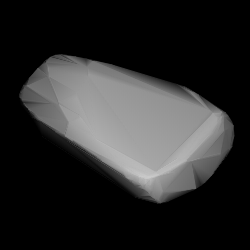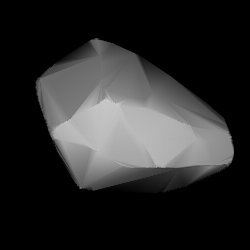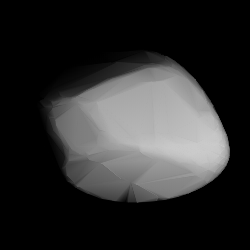
333 Badenia is a large background asteroid, approximately 72 kilometers in diameter, located the outer region of the asteroid belt. It was discovered on 22 August 1892, by astronomer Max Wolf at the Heidelberg-Königstuhl State Observatory in southwest Germany. The carbonaceous C-type asteroid has a rotation period of 9.9 hours. It was named after the historical Grand Duchy of Baden that existed until 1918, and where the discovering observatory is located. Badenia was the first asteroid to receive a provisional designation.
460 Scania is a background asteroid and a slow rotator from the central regions of the asteroid belt. It was discovered by German astronomer Max Wolf at the Heidelberg-Königstuhl State Observatory on 22 October 1900. The uncommon K-type asteroid has an exceptionally long rotation period of 164.1 hours and measures approximately 21 kilometers in diameter. It was named after the Swedish region of Scania, where a meeting was held by the Astronomische Gesellschaft in 1904.
464 Megaira is a dark and large background asteroid, approximately 77 kilometers in diameter, located in the central region of the asteroid belt. It was discovered by astronomer Max Wolf at the Heidelberg Observatory in southwest Germany on 9 January 1901. The carbonaceous C-type asteroid (FX) has a rotation period of 12.9 hours. It was named after Megaera from Greek mythology.
865 Zubaida is an elongated, stony background asteroid from the inner regions of the asteroid belt. It was discovered on 15 February 1917, by astronomer Max Wolf at the Heidelberg Observatory in southwest Germany, and given the provisional designations A917 CH and 1917 BO. The uncommon L-type asteroid has a rotation period of 11.4 hours and measures approximately 17 kilometers in diameter. It was named after Zobeide, a character in the opera Abu Hassan by Carl Maria von Weber (1786–1826).
914 Palisana, provisional designation 1919 FN, is a Phocaean asteroid from the inner regions of the asteroid belt, approximately 77 kilometers in diameter. It was discovered by German astronomer Max Wolf at Heidelberg Observatory on 4 July 1919.
930 Westphalia is a very dark background asteroid and a slow rotator from the inner regions of the asteroid belt, that measures approximately 36 kilometers in diameter. It was discovered on 10 March 1920, by German astronomer Walter Baade at the Bergedorf Observatory in Hamburg. The carbonaceous C-type asteroid (Ch) has an exceptionally long rotation period of 100.7 hours and is likely spherical in shape. It was named after Westphalia, a region in northwestern Germany.

961 Gunnie is a very dark background asteroid from the central regions of the asteroid belt, approximately 37 kilometers in diameter. It was discovered on 10 October 1921, by German astronomer Karl Reinmuth at the Heidelberg-Königstuhl State Observatory. The C/X-type asteroid has a rotation period of 21.4 hours. It was named after Gunnie Asplind, daughter of Swedish astronomer Bror Asplind (1890–1954).
965 Angelica, is a large background asteroid from the outer regions of the asteroid belt, approximately 60 kilometers in diameter. It was discovered on 4 November 1921, by astronomer Johannes F. Hartmann at the La Plata Astronomical Observatory in Argentina. The dark X-type asteroid (Xc) with a low TJupiter has a rotation period of 26.8 hours and is likely spherical in shape. It was named after the discoverer's wife, Angelica Hartmann.
974 Lioba is a stony background asteroid from the central regions of the asteroid belt, approximately 25 kilometers in diameter. It was discovered on 18 March 1922, by astronomer Karl Reinmuth at the Heidelberg-Königstuhl State Observatory in southern Germany. The S-type asteroid has a longer than average rotation period of 38.7 hours. It was named after missionary Saint Leoba (Lioba).
989 Schwassmannia is a stony background asteroid and a slow rotator from the central regions of the asteroid belt, approximately 12.5 kilometers in diameter. It was discovered on 18 November 1922, by astronomer Friedrich Karl Arnold Schwassmann at the Bergedorf Observatory in Hamburg, Germany. The bright S/T-type asteroid has a long rotation period of 107.9 hours. It was named after the discoverer himself.

1069 Planckia, provisional designation 1927 BC, is a background asteroid from the outer regions of the asteroid belt, approximately 39 kilometers in diameter. It was discovered on 28 January 1927, by astronomer Max Wolf at the Heidelberg-Königstuhl State Observatory in Germany. The asteroid was named after German physicist Max Planck.

1137 Raïssa is a stony background asteroid and slow rotator, approximately 22 kilometers in diameter, located in the inner regions of the asteroid belt. It was discovered by Grigory Neujmin at Simeiz Observatory in 1929, and named in memory of Raïssa Maseeva, who worked at the Pulkovo Observatory.

1390 Abastumani is a very large and dark background asteroid from the outer region of the asteroid belt. It was discovered on 3 October 1935, by Russian astronomer Pelageya Shajn at the Simeiz Observatory on the Crimean peninsula. The primitive P-type asteroid has a rotation period of 17.1 hours and measures approximately 101 kilometers in diameter. It was named for the Georgian town of Abastumani.

1187 Afra is a dark background asteroid from the central regions of the asteroid belt. It was discovered by German astronomer Karl Reinmuth at Heidelberg Observatory on 6 December 1929. The X-type asteroid has a rotation period of 14.1 hours and measures approximately 32 kilometers in diameter. The origin of the asteroid's name remains unknown.
12714 Alkimos is a large Jupiter trojan from the Greek camp, approximately 54 kilometers in diameter. It was discovered on 15 April 1991, by American astronomer couple Carolyn and Eugene Shoemaker at the Palomar Observatory in California. The dark Jovian asteroid has a rotation period of 28.5 hours. It was named from Greek mythology after Alcimus, son of Ares and companion of Achilles.
3141 Buchar, provisional designation 1984 RH, is a dark Cybele asteroid from the outermost region of the asteroid belt, approximately 36 kilometers in diameter. It was discovered on 2 September 1984, by Czech astronomer Antonín Mrkos at the Kleť Observatory. The D-type asteroid has a rotation period of 11.4 hours. It was named in memory of Czechoslovakian astronomer Emil Buchar.

2204 Lyyli is a dark asteroid and very eccentric Mars-crosser from the middle region of the asteroid belt, approximately 25 kilometers in diameter. It was discovered on 3 March 1943 by Finnish astronomer Yrjö Väisälä at Turku Observatory in Southwest Finland.
4543 Phoinix is a large Jupiter trojan from the Greek camp, approximately 63 kilometers in diameter. It was discovered on 2 February 1989, by American astronomer Carolyn Shoemaker at the Palomar Observatory in California. The assumed C-type asteroid is possibly elongated and has a longer-than-average rotation period of 38.9 hours. It is one of the 60 largest Jupiter trojans and was named after Phoenix (Phoinix) from Greek mythology.
12444 Prothoon is a large Jupiter trojan from the Trojan camp, approximately 64 kilometers in diameter. It was discovered on 15 April 1996, by Belgian astronomer Eric Elst at the La Silla Observatory in northern Chile. The assumed C-type asteroid is one of the 60 largest Jupiter trojans and has a rotation period of 15.82 hours. It was named after Prothoon from Greek mythology.
2995 Taratuta, provisional designation 1978 QK, is a stony Eunomian asteroid from the middle region of the asteroid belt, approximately 17 kilometers in diameter. It was discovered on 31 August 1978, by Russian astronomer Nikolai Chernykh at the Crimean Astrophysical Observatory, Nauchnyj, on the Crimean peninsula. The asteroid was later named after Soviet writer Yevgeniya Taratuta.







